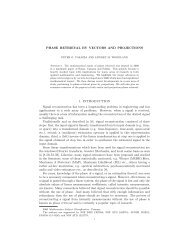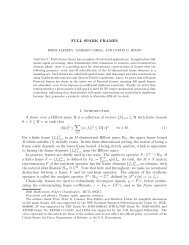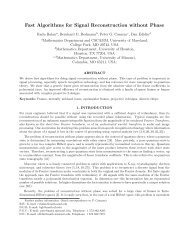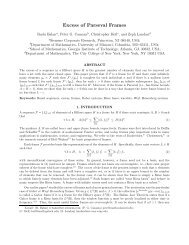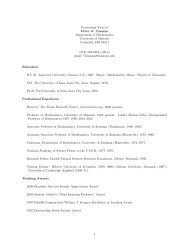Introduction to Finite Frame Theory - Frame Research Center
Introduction to Finite Frame Theory - Frame Research Center
Introduction to Finite Frame Theory - Frame Research Center
Create successful ePaper yourself
Turn your PDF publications into a flip-book with our unique Google optimized e-Paper software.
<strong>Introduction</strong> <strong>to</strong> <strong>Finite</strong> <strong>Frame</strong> <strong>Theory</strong> 5<br />
2 Background Material<br />
Let us start by recalling some basic definitions and results from Hilbert space theory<br />
and opera<strong>to</strong>r theory, which will be required for all subsequent chapters. We do not<br />
include the proofs of the presented results, and refer <strong>to</strong> the standard literature such<br />
as, for instance, [153] for Hilbert space theory and [71, 105, 130] for opera<strong>to</strong>r theory.<br />
We would like <strong>to</strong> emphasize that all following results are solely stated in the finite<br />
dimensional setting, which is the focus of this book.<br />
2.1 Review of Basics from Hilbert Space <strong>Theory</strong><br />
Letting N be a positive integer, we denote by H N a real or complex N-dimensional<br />
Hilbert space. This will be the space considered throughout this book. Sometimes,<br />
if it is convenient, we identify H N with R N or C N . By 〈·,·〉 and ‖ · ‖ we denote the<br />
inner product on H N and its corresponding norm, respectively.<br />
Let us now start with the origin of frame theory, which is the notion of an orthonormal<br />
basis. Alongside, we recall the basic definitions we will also require in<br />
the sequel.<br />
Definition 1. A vec<strong>to</strong>r x ∈ H N is called normalized if ‖x‖ = 1. Two vec<strong>to</strong>rs x,y ∈<br />
H N are called orthogonal if 〈x,y〉 = 0. A system (e i ) k i=1 of vec<strong>to</strong>rs in H N is called<br />
(a) complete (or a spanning set) if span{e i } k i=1 = H N .<br />
(b) orthogonal if for all i ≠ j, the vec<strong>to</strong>rs e i and e j are orthogonal.<br />
(c) orthonormal if it is orthogonal and each e i is normalized.<br />
(e) orthonormal basis for H N if it is complete and orthonormal.<br />
A fundamental result in Hilbert space theory is Parseval’s Identity.<br />
Proposition 1 (Parseval’s Identity). If (e i ) N i=1 is an orthonormal basis for H N ,<br />
then, for every x ∈ H N , we have<br />
‖x‖ 2 =<br />
N<br />
∑<br />
i=1<br />
|〈x,e i 〉| 2 .<br />
Interpreting this identity from a signal processing point of view, it implies that the<br />
energy of the signal is preserved under the map x ↦→ (〈x,e i 〉) N i=1<br />
which we will later<br />
refer <strong>to</strong> as the analysis map. We would also like <strong>to</strong> mention at this point, that this<br />
identity is not only satisfied by orthonormal bases. In fact, redundant systems (“nonbases”)<br />
such as (e 1 , √ 1<br />
2<br />
e 2 , √ 1<br />
2<br />
e 2 , √ 1 3<br />
e 3 , √ 1<br />
3<br />
e 3 , √ 1 1<br />
3<br />
e 3 ,..., √ 1<br />
N<br />
e N ,..., √<br />
N<br />
e N ) also satisfy<br />
this inequality, and will later be coined Parseval frames.<br />
Parseval’s identity has the following implication, which shows that a vec<strong>to</strong>r x can<br />
be recovered from the coefficients (〈x,e i 〉) N i=1<br />
by a simple procedure. Thus, from<br />
an application point of view, this result can also be interpreted as a reconstruction<br />
formula.



